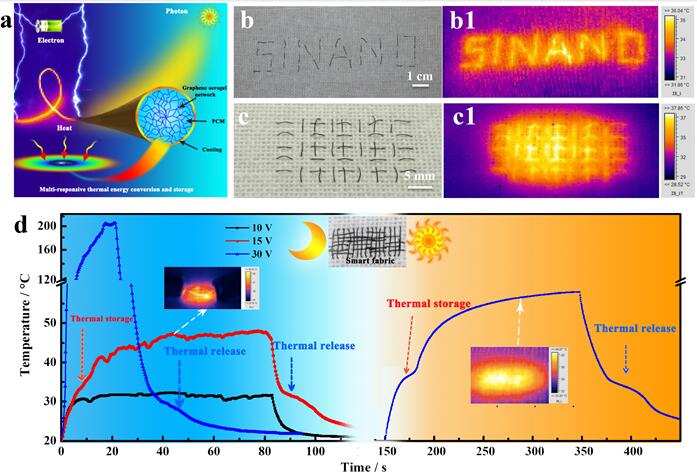Smart fibre, an essential unit for wearable electronics, which could response to external stimuli, such as photonic, electrical, and thermal signal, etc. This fibre could be woven as fabric and integrated into armband, cuff, clothing, helmet, belt and other parts. It also has broad applications as the core cell in the intelligent wearable systems, such as sensors, actuators, energy harvesting devices, thermal-regulating clothes, heaters, etc. However, current textile fibres, made from either natural or synthetic polymers, are intrinsically electrically and thermally insulating, which limit the applications in sensors and actuators. Moreover, intelligent and integrative functions in response to multistimuli from complex environment and human-machine interface are still challenging.
To realize intelligent and integrative functions in multiresponsive textile fibres, the Aerogel Team of the Chinese Academy of Sciences led by Prof. ZHANG Xuetong at Suzhou Institute of Nano-Tech and Nano-Bionics, Chinese Academy of Sciences developed a novel graphene-aerogel-directed phase-change smart fibre via the combination of graphene aerogel fibre, phase change material (PCM) and fluorocarbon (FC) resin coating. This fibre is flexible and self-cleaning, which can response to multi-stimuli (photo/electric/heat), capable of thermal energy conversion and storage, self-regulating, and controlled heating, etc.
This graphene aerogel-directed smart fibre was fabricated by impregnating PCMs into graphene aerogel fibre and coating of FC in sequence. The graphene aerogel fibre had a 3D interconnected porous network, and it was flexible, conductive and multi-responsive. The PCMs could store and release thermal energy during phase change process at a constant temperature, and the phase-transition temperature could be controlled with different types of PCMs, such as paraffin, polyethylene, fatty acids, etc. The FC coating was super-hydrophobic, which provides a self-cleaning function.
To demonstrate the multiresponsive behavior, the external stimuli of temperature, electrical voltage and solar irradiation were applied to smart fibres, respectively. During the temperature variation, the melting and freezing processes of PCM were observed from differential scanning calorimetry curve, and the phase change temperature point and enthalpies (0-186 J/g) were tunable. With different electrical voltages or solar irradiation, the smart fibre exhibited excellent electric-heat and solar-heat responsive behavior. Furthermore, the graphene-aerogel-directed smart fibres were woven into fabric and the response of fabric under different environment variables (stress, temperature and humidity) and different fibre densities were investigated. As shown in Figure 1, the temperature plateaus (temperature hysteresis) were observed, which indicates the integrative functions of fabric on heating, thermo-regulating and energy harvesting.
In conclusion, this graphene-aerogel-directed smart fibre could be woven into fabric with intelligent and integrative functions and promising for applications in wearable fabrics and portable electrical devices suitable for a range of varying conditions. This work was titled as “Multiresponsive Graphene-Aerogel–Directed Phase-Change Smart Fibers”, and been published on Advanced Materials.

Figure 1 Illustration of multi-responsive graphene-aerogel-directed phase-change smart fibre (a), the photograph (b) and IR image under light irradiation (b1) in a letter pattern (SINANO) sewn on a white fabric, the photograph (c) and IR image under light irradiation (c1) of graphene-aerogel-directed phase-change firbes (black) woven together cotton fabric (white), the temperature-time curves of graphene-aerogel-directed smart fibre fabric under different electrical voltage and light irradiation.(Image by SINANO)
This work was financially supported by the National Key Research and Development Program of China (Grant No. 2016YFA0203301), the National Natural Science Foundation of China (Grant No. 51572285), the Natural Science Foundation of Jiangsu Province (Grant No. BK20170428), and the Royal Society Newton Advanced Fellowship (NA170184). Wenhui Song would like to thank the UK Engineering and Physical Sciences Research Council for the nancial support (Grant Nos. EPSRCEP/L020904/1 and EP/M026884/1). Guo Hong would like to thank the University of Macau and Science and Technology Development Fund (Grant No. 081/2017A2), Macao S.A.R. (FDCT), for the Start-up Research Grant (Grant No. SRG2016-00092-IAPME)
Contact information:
Prof. ZHANG Xuetong, Suzhou Institute of Nano-Tech and Nano-Bionics, Chinese Academy of Sciences
E-mail: xtzhang2014@sinano.ac.cn
Reference:https://onlinelibrary.wiley.com/doi/abs/10.1002/adma.201801754
Link:http://www.aerogel-online.com/index.php

